#but some of their architecture would be based on some of the indigenous architecture in central + south america
Explore tagged Tumblr posts
Text
hm. working on my map of lorule. need to figure out some things......
#libra.txt#if any mutuals wanna help me worldbuild please feel free to message me / ask for my discord or smth#in albw instead of a desert there's a swamp right#so i wanted to change hyrule's gerudo desert to lorule's giant swamp#but then that could imply changing the faron region and/or parts of lanayru to desert ?#and i do want to have some lorule zora so we couldn't have them in a desert#and yeah on the albw map there's just lots of swamp#but i think the stuff in lower right is the lake hylia swap#i haven't played albw in ages..... might need to go through it again for ideas#like i knoooww not everything needs to be a 1:1 inverse. and i'm not planning to do that!#i'm mostly trying to adhere to what we're given in canon#and yeah hyrule's map has changed a LOT from albw > botw#and therefore lorule's map could too!#although i def want to keep with the canyons that split the land after the destruction of the triforce#and a lot of the land would definitely heal post-new triforce get#but i do like the swamps.........#wanted to make a gerudo inverse who live in the swamp#but some of their architecture would be based on some of the indigenous architecture in central + south america#and i would need to do LOTS of research to make it accurate and interesting etc#(even though. no idea how much would actually come up in the story)#yes this is just. my silly au and i get to cherrypick which bits of lore get included#and i'm making some stuff work that wouldn't by lore standard!#(why are there yeti and mogmas in lorule libra. shhh don't worry abt it)
5 notes
·
View notes
Text
Race Headcannons 🥀🌼
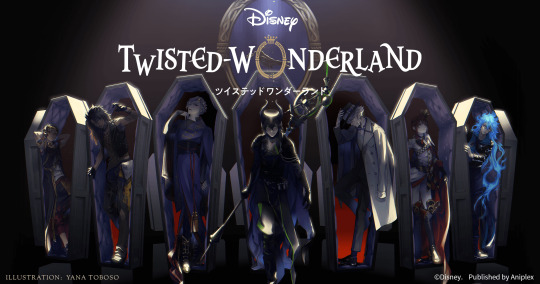
Requested: Nu uh I just felt like it
CW: Race, Rook Slander, Ortho spoiler Idia's part.
Characters: NRC students
These are my Race Headcannons for the NRC men. Some of these I just went by feeling a lot of these I did research about the movie setting although with the fishes + beast men I went by geography.
Some of these I'm unsure of (Heavy on Sebek) If anything is incorrect or you want to share your thoughts go ahead I'm always open to corrections and hearing others. (PROOFREAD FOR ONCE)
(Updated Epel on 5.12.24)
🌼

Heartslabyul
Riddle (British)
I don't really have an explanation for this one other than the Red Queen in Tim Burton's version she was British and had a big goofy forehead (I have not seen the animated one help)
Trey (German)
Would you believe me if I told you I whipped out a map closed my eyes and threw a dart and it landed on Germany??
For this one I went with somewhere in Europe and I picked Germany because it just made sense to me I was gonna say Polish, but his Green hair was telling me German.
Cater (Scottish)
It's his ginger hair tbh.
Ace (Japanese)
A lot of people headcannon him as Filipino, but me personally I wanted to be quirky and different /j
This one doesn't really have any evidence I just went by feeling. I also headcannon it that he would love Jojo and Junji Ito.
Deuce (Mexican)
As a fellow Mexican I KNOW ONE OF US WHEN I SEE ONE OF US. He is Mexican and I WILL DIE ON THAT HILL.
Savanaclaw
Leona (Kenya)
I actually googled it and Lion King takes place in Kenya which is a country in the eastern part of Africa. For obvious reasons since he is based off Scar it made sense to make him Kenyan.
Ruggie (Multiracial)
I may get a lot of heat for this one, but this man got blonde ass hair and blue eyes, HOWEVER for the geography of spotted Hyena's I feel he is light skinned. He's got some Kenya in him but he also got some white genes. Geography wise I believe he is also part Arab since there are Arab countries in Africa. So therefore I believe he is white, black, and Arab.
Jack (Bircial)
Another one I may get a lot of heat for.
From what I remember Jack is from the same country as Vil? So, I believe Jack is part black, but also part European. It also isn't explicitly stated what movie he is from we just know he is a wolf.
Pop off Jacob Black (not sorry)

Octavinelle
Azul (Cuban) + The Twins (Filipino)
I googled Coral Sea locations and I came to these conclusions.
There are different Coral reefs going from Australia, Indonesia, Papua New Guinea, Fiji, and Maldives. With the Twins I thought how funny would it be to make them Australian, but Filipino just kind of felt right like a gut feeling. The Carribean sea also has coral reefs so I made Azul Cuban. I was going to make him Venezuelan however I ended up going with Cuban, but I feel like both fit him in a way.
Scarabia
Jamil + Kalim (Arab)
I don't really think this one needs an explanation Aladdin quite literally takes place Agrabah which was based off of Baghdad, Iraq (source: Google)
HOWEVER
There is an article that says the Architecture is based on the Taj Mahal which is Indian.
There is also a mention of Allah in the animated version BUT because I don't fully understand religion in general (And also Disney back then was kind of racist) I don't want to use religion as a justification to where specifically they are from. So I will simply just say they are Arab.
Pomefiore
Vil (German)
Snow white was based in Germany. (I have nothing more to say :Skull:)
Rook (French)
Self explanatory
Epel (Sami)
The Sami People are people who are indigenous to Sapmi which is in Northern Europe. (Todays Russia, Sweden, Finland, and Norway).
From doing a bit of research the Sami people seem to be dying out and their language too. (If you want to feel free to Google the Sami people there's a lot to learn about them and it's really interesting. There was basically a bunch of policies put in place to kill them and mistreat them it's really sad)
So in short Epel is Sami Indigenous (If I'm correct he's the first Indigenous character we got so far which is nice representation) (I also hope my research was correct please correct me if not)
Ignihyde
Idia (Greek)
Based on where Hercules takes place and because Hades is quite literally Greek Mythology he is Greek.
Ortho is just a robot, but when he didn't drop dead he was Greek.
Diasmonia
Malleus (German/French)
I am not really getting a clear answer as to where Sleeping Beauty takes place so I made him a French German. He slayed tbh
Lilia (Romanian)
Dracula's castle is in Romania that is the only explanation you are getting
Silver (French/German)
I am being told he is based off Sleeping Beauty so I am making him the same race as Waka Sama.
Sebek (Biracial)
When I first was thinking of a race for him I was thinking Slavic kind of fits him (atleast to me) or possibly Asian. However I had a really hard time guessing so I made him SlavicAsian. Maybe possibly Slovakia and Vietnam?
If you enjoyed Likes and Reblogs are very much welcome. If you want to request something go ahead just read my rules first. <3
#twisted wonderland#disney twisted wonderland#disney twst#twst wonderland#heartslabyul#riddle rosehearts#trey clover#cater diamond#ace trappola#twst ace#deuce spade#twst deuce#twst riddle#twst cater#twst trey#savanaclaw#leona kingscholar#twst leona#ruggie bucchi#twst ruggie#jack howl#twst jack#octavinelle#azul ashengrotto#floyd leech#twst azul#twst floyd#jade leech#twst jade#scarabia
45 notes
·
View notes
Text
One of the great tragedies of the Rust Belt* is that it did not define itself as a distinct cultural region until well after its great era of flourishing was over. For the century from about 1850-1950, this area was not merely the industrial heart of the nation, but also its cultural center. And yet the inhabitants of the area, if they thought of themselves as having a regional identity at all, it was as inhabitants of the generic ‘north’. Its status as a center of cultural innovation was pooh-poohed by the fact that the nation’s political and intellectual elite was, even as it is today, strongly based to the coastal northeast, and this Eurocentric elite had a very different set of priorities than the cultural avant-garde of the as-yet-unRusted-Belt. This area produced little in the way of ‘high art’ in the expected form of novels, symphonies, and oil paintings. But what it did produce...
In 1900, Chicago was the occult capital of the nation, a hotbed of wild theorizing and underground publishing of all manner of Theosophical weirdness. Meanwhile, Louis Sullivan and Frank Lloyd Wright were producing the first wholly indigenous tradition of monumental architecture, setting a pattern for all of urban modernity. The Dayton, Ohio based Wright brothers - often abused in pop-historiography as some sort of rude mechanicals - were slowly and methodically systematizing the science of aerodynamics in preparation for the first ever instance of heaver-than-air flight in human history, with world-shaking consequences. And up in Detroit, Henry Ford was not merely revolutionizing transportation and manufacturing, but setting a standard for industrial relations that would create an unbelievably influential model for decades to come. It might sound strange to modern ears to cite Henry Ford as a bleeding-edge figure, but Fordism served as an inspiration to both Bolsheviks and Fascists, as well as to domestic New Dealers, while simultaneously pleasing and alarming old-fashioned Anglo liberals. The Long 20th Century is a series of footnotes to the Rust Belt Golden Age.
As can be seen from this too-brief summary of the luminaries of the epoch, it was a deeply unique Golden Age, characterized by cultural traits all its own. Technical prowess, utopian visions, and thorough systematization were its characteristics, as was a sense that a lone individual or small group could, through sheer innovative genius, change the world. While the archetype of the Mad Scientist is based on Mitteleuropean models, it was here in Mittelamerika that it achieved its apotheosis. The definitive cultural history of this region and era has yet to be written**, which just shows how underappreciated the underlying unity still is, but it in a large part contributed to the dynamic optimism that we all now take for granted as distinctively ‘American.’ But as the area felt the collapse of the long bubble economy that funded its flourishing, and its brightest sons and daughters fled west to contribute to the explosion of creativity along the Pacific slope that is now likewise collapsing, it finally awakened to a sense of unity that had previously been hidden by arbitrary State boundaries.
That, at some point, this area will again be the center of some sort of vigorous culture seems an inevitability of human geography, but will it again share the same features of optimism and technical prowess, or were those mere incidental features of a bunch of people with a Protestant work ethic suddenly getting access to the tremendous wealth provided by a vast agricultural base + fossil fuels? Man alive, I don’t have the slightest clue, but I hope that there is some sort of afterlife or metempsychosis so I can find out.
* here roughly defined as the geographical area constrained by an irregular polygon whose points are Syracuse, Pittsburgh, Cincinnati, St. Louis, Davenport, Green Bay, and Flint.
** unless it has and i’m just ignorant of it, in which case please let me know so i can rest easy that i don’t need to do any work and can just sit down and read the thing. honestly, even tangentially related book recommendations are appreciated.
97 notes
·
View notes
Text

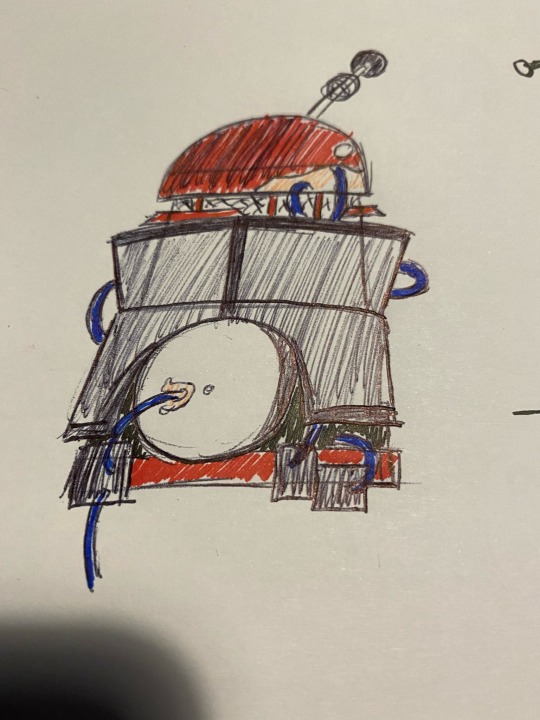

ᴜɴɪᴛ xᴢ-477/ᴊᴇʀᴇᴍʏ
477 was created during the early days of the new empire, a unit specifically breaded to lead the invasion of earth and be an almost perfect killing machine, no special rank, just a normal dalek who was exceeded at his occupation. While the emperor and the other currently existing dalek forces where left to conquer the outer worlds near Skaro and occupy space to claim as there own a separate force would be sent long distance across the galaxy to conquer a small planet known as Earth. Leading this occupation 477 would take the role of supreme controller and over the next 10 years would enslave the populace and integrate dalek architecture into humanities own cities. In this time resources where completely drained, entire oceans lost and half of North America was completely obliterated. During this time large resistance groups were building, and the scientists of an unknown organisation known as ‘Black Mesa’ decided there was nothing they could do to save humanity. Activating a machine that would open mass portals to the boarder world, allowing creatures and horrors of all sorts to invade the earth and creating a hell that neither daleks or humanity could survive, hoping that some humans would be able to survive in hiding. The daleks over the course of the next 24 hours would be overrun, their cities and citadels obliterated with only a few ships being able to escape. However, 477 was left behind to die by his comrades. Successfully fighting to keep himself safe in a citadel he was able to uses its main core processors to shut down the portals. Before he could escape the floors and internal structure of the citadel collapsed and unit 477 fell beneath the earth, rumble on top of him, he was trapped. Buried beneath the rock, there was nothing but his own life, his failures and success, his reasoning to ruminate on.
A century passed and the remaining humans on earth that had survived and repopulated ended up rediscovering the underground system. Digging out the remains of it to set up camps a woman named Eliza discord 477, digging him up and reactivating him. While she had him locked up for a bit overtime they started to grow closer with Eliza eventually letting 477 roam freely, to her surprise he had grown docile. In his mind however he had realised the flaws of his own species, they abandoned him and no rescue was sent for 100 years, but this woman who’s species he had terrorised saved him. Now with the new name Jeremy(which Eliza had given to 477) they left the earth together to start exploring the galaxy, their friendship growing and blooming until one day when Eliza and Jeremy got trapped during a dalek invasion. Right in front of Jeremy’s eyes Eliza was exterminated by his own species, with no choice he went into hiding and was left damaged and alone once more. But this time, he had a plan.
He burrowed and hid in a lair under the village for the next 30 years. He enslaved the villagers and indigenous species populating the planet to aid him in his plans. He created his own new bloodstream to give him more mental strength to not loose his own sanity and to keep his mutant nourished, but this would unintentionally change his DNA, making him impure in the process. It was like an infection that he was oblivious to due to how deranged he got over time, the new source of blood did not help him, but it kept him alive. When he had the perfect opportunity he sent out and distress signal, eradicating all the villages before boarding the rescue ship. Once onboard 477 exterminated the whole crew, killing every dalek onboard and then proceeded to take the ship for himself. Before his disconnection form the dalek path web he knew what his emperor had planned for his base copy, he was to be re used to make a new special forces dalek, ‘Xendiyatrix’. He also knew of a special plan to go to the edge of the galaxy, there was something there that the daleks and imperials wanted ahold of, something life changing.
Jez arrived at the edge of the galaxy, his mission already set. He infiltrated the occupations set up there, fighting through daleks and stormtroopers a like, but there was someone, something in his way. 3605. This was the first time Jez faced a proper challenge, he tried persuading and reasoning with 3605 over the course of their mission but with no choice left Jez sought to kill 3605 himself. As they fought Jez found himself losing, here he was clearly outmatched as not only was 3605 a skilled soldier but was able to wield a lightsaber and was the best sniper in the entire imperial empire. Jez was blown up and left burning, fleeing form 3605. In his last moments of life he saw what he came looking for, sitting across the large ravine that kept them apart. Jez had one last conversation with 3605, pleading with him to spare him and work together, but his demise was sealed as a psyche, a new breed of dalek which Jez had never seen himself before. Before Jez could question further in an instant the psyche dalek used it’s telekinetic abilities to drop a crate onto Jez, crushing him and completely ending his life.
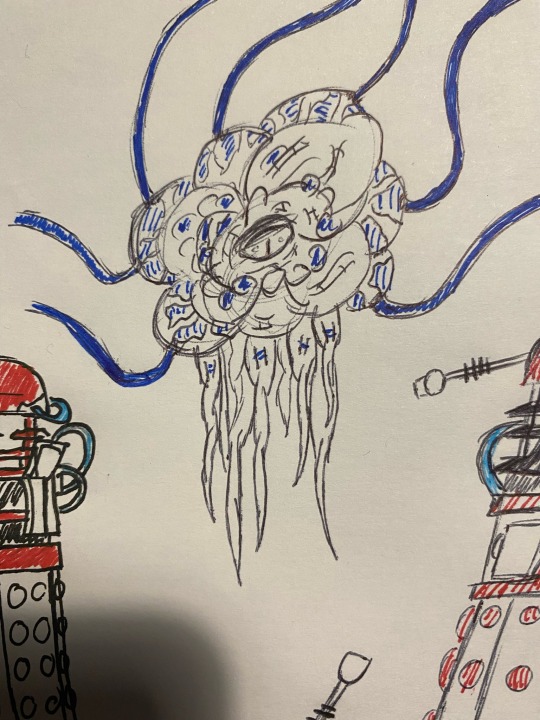
-mutant design
#doctor who#dalek#daleks#dalek oc#my oc lore#my oc art#Xendiyatrix#sorry if this one was a bit long#and yappy#tried my best lol
15 notes
·
View notes
Text
A series of notes on my cultural/fashion inspiration for some miscellaneous houses and regions within ASOIAF! Unfinished bc I can only fixate on so many families. A basic rule of thumb is that fashion may overlap closer to borders or with characters who have a close connection to a region outside of their native one. Not tagging this bc it’s a commentary to go with my own art and not an analysis of actual inspirations for Westerosi cultures. Like at all.
The Northmen (-Iron Islands) : the main inspirations I’ve always come back to for the North is Indigenous and Slavic inspirations. I use First Nations, Inuit, and Métis fashion influences alongside Slavic fashion as well. In terms of ethnicity it’s a mixed bag as well. The Starks, minus the inclusion of Cat, in particular I’ve always seen as Algonquin, based on the irl region of these people spanning north in wooded regions. Ukrainian fashion specifically comes to mind as an inspiration for many of my pieces, including those I’ve yet to post.
The Iron Islands: Scandinavian 100%. I do imagine a lot of overlap from the mainland indigenous-inspired population, which also has irl historical merit, fun fact (Erikson’s expedition circa 1000). Major Viking vibes with the islands, as GRRM intended. I also like to include “foreign” jewelry, fashion, and accessory styles with Ironborn designs due to the Iron Price, as well as their trading with foreign merchants.
The Free Folk: Iron Islands/Northmen love child. Scandinavian and Indigenous inspirations, though the Slavic has fallen out at this point. More Inuit inspired fashion starts appearing in my inspo list at this point.
Riverlands: Ireland. House Tully especially. Those girls are Irish. Plaids are common fashion, which overlaps into the Stormlands (see Stormlander category). Flowing fabrics and leather armour alongside the more modern chainmail. Knotted pattern embroideries. This would make the Stark kids, minus Jon, Indigenous-Irish inspired, though most take after their mother over their father.
Stormlands: Scottish icons. Especially House Baratheon and House Connington. Like the Tullys, plaid is a common fashion. Tight hairstyles or head coverings for women for efficiency against the wind. Differs for formal wear where weather is not an issue. Paler features due to lack of sun, rather weather beaten depending on the occupation and habits of the person (do they sail often, do they hunt despite the weather, etc). Thick Scottish accents because there’s no way Robert and Jon don’t have a Scottish accent, I don’t buy them being British one bit. Kilts would be pretty cool too. Generic historical drama chainmail with a hint of kilts or plaids depending on the person in question.
The Reach: Mediterranean Europe is my go to for the Reach. Dark hair, tan skin, artistic clothing. A huge focus on art and renaissance, with fashion and accessory inspirations coming in from Dorne in the south. Italian renaissance, with a hint of Tudor England in the fashion. The wealth of the region is evident in the higher class’ fashion sense. Nice jewelry, embroidery, and fabrics. Even prettier armour.
The Westerlands : to be determined. I’ve been playing with a bunch of different fashion eras and have settled on Tudor as a default, but this may change. I’ve been debating playing around with French and German fashion in the future.
Dorne: I read somewhere that Dorne was inspired by Palestine, “Moorish” or Islamic Spain, and Wales (?) and the first two stuck with me. Don’t know where the third one came from but ok. North African/European/West Asian cultural overlap. Islamic European fashion and architecture is a new endeavour of mine so I’m still playing around with combinations and stuff but I have the vibe figured out. Ethnically, North African and West Asian inspired peoples with more European overlap or even complete European the further north. Different houses/regions have different irl inspirations but that’s too deep for me to dig into at the moment.
The Targaryens : BYZANTINE!!! The oldest Targaryens of old Valyria were Byzantinian, yet the fashion and culture began drifting away and is only present in small forms by the time Rhaegar and Viserys come into the picture. Now the fashion inspiration for the Targs is often imitations of fashion from different kingdoms within the Targ empire. Ie Rhaegar was probably a Reach fashion kinda guy.
The Vale: I’m gonna be honest with you I often forget these guys exist and have put almost zero thought into them. English? I have no idea.
Dothraki: Mongolian. Not gonna go much deeper as I’ve yet to explore Essosi inspo.
30 notes
·
View notes
Text

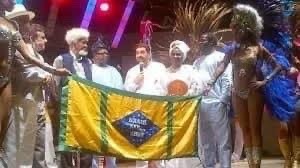
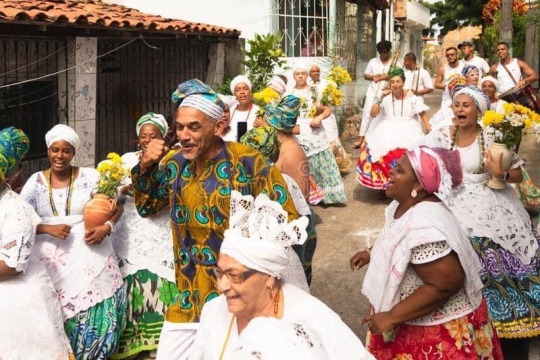


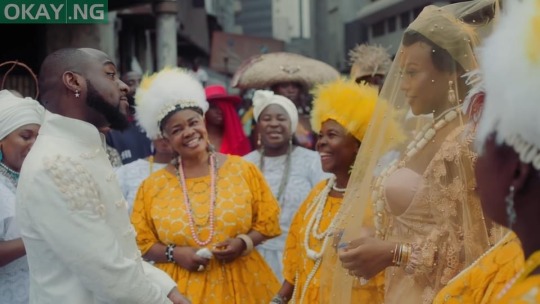

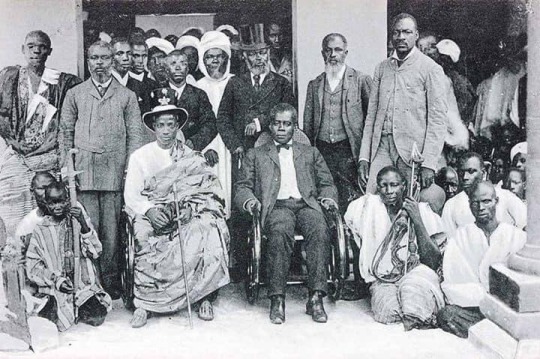
AFRO BRAZILIANS OF NIGERIA
🇳🇬🇧🇷🇳🇬🇧🇷🇳🇬🇧🇷🇳🇬🇧🇷
Brazilians in Nigeria, Amaros or Agudas consist of the descendants of freed Afro-Brazilian slaves who left Brazil and settled in Nigeria. The term Brazilians in Nigeria can also otherwise refer to first generation expatriates from Brazil.
🇧🇷🇳🇬
Starting from the 1830s, many emancipated Africans who had been through forced labour and discrimination in Brazil began moving back to Africa, noteably Nigeria, with the largest number, being in Lagos, while other regions with significant populations were
Lagos, Abeokuta, Ibadan, Warri, Calabar, and Port Harcourt, bringing along with them some cultural and social sensibilities adapted from their sojourn in Brazil. These emancipated Africans were often called "Aguda" or "Amaro", and also included returnees from Cuba. As of today there are less than 200 Brazilian citizens registered within the consulate in Nigeria.
🇳🇬🇧🇷
At the height of the Transatlantic slave trade in West Africa, many prisoners of war or those kidnapped for sale in slave markets were sold to Europeans and transported across the Atlantic. Estimates of the number of slaves from the Gulf of Guinea to Brazil totaled about 300,000 in the nineteenth century. The captives disembarked in Bahia before moving further south to work on plantations, assist tradesmen or hawk goods for white Brazilians. As some gained manumission, earned savings or got deported as a result of racism, waves of African migration back to the West African coast developed. By the middle of the nineteenth century, an Afro-Brazilian community had begun to emerge along the West African coast, developed by descendants of slaves who had twice crossed the Atlantic. These Africans brought back Afro-Brazilian sensibilities in food, agriculture, architecture and religion.
🇧🇷🇳🇬
The first recorded repatriation of African people from Brazil to what is now Nigeria was a government-led deportation in 1835 in the aftermath of a Yoruba and Hausa rebellion in the city of Salvador known as the Malê Revolt. After the rebellion, the Brazilian government - fearful of further insurrection - allowed freed or manumitted Africans the option to return home or keep paying an exorbitant tax to the government. A few Africans who were free and had saved some money were able to return to Africa as a result of the tough conditions, taxation, racism and homesickness. In 1851, 60 Mina Africans put together $4,000 to charter a ship for Badagry.
After slavery was abolished in Cuba and Brazil in 1886 and 1888 respectively, further migration to Lagos continued. Many of the returnees chose to return to Nigeria for cultural, missionary and economic reasons. Many of them descended from the Yoruba. In Lagos, they were given the watery terrains of Popo Aguda as their settlement. By the 1880s, they comprised about 9% of the population of Lagos. Towards the end of 1920, the migration stopped.
🇳🇬🇧🇷
Though coastal Lagos was the preferred destination, most of the returnees were descendants of groups such as Ijeshas, Oyos, Ijebu and Egba based in the interior. The Agudas were aware of their home cities but preferred to set up shop in Lagos because it was conducive for trade, they were warmly received in Badagry and also because of on-going wars in the interior. A ship with Agudas docking in Badagry would be welcomed by crowds of children hailing them as they disembarked from the ship, whereas in the hinterlands strangers were viewed with suspicion. In some cases, the Oba of Lagos gave them land to build a house and provided men to assist them in their transition to local life. This notwithstanding, Lagos was different from Bahia. The elder returnees were comfortable, but many of the children were foreign to Lagos. They held on to elements of Bahia culture such as Catholicism and formed a close knit community within Lagos Island. Because of the retention of Catholicism and Western dressing, indigenous Africans called them "black whites" or Agudas. Keen on acquiring wealth in Africa, some of the earliest Agudas were morally ambivalent on issues such as slavery and became slave traders themselves, such as the descendants of Francisco Felix de Sousa and Domingo Martinez.
Returnees from Brazil and their present-day descendants were and are more commonly called "Agudas" (from agudão, a non-standard Portuguese word for cotton properly rendered as algodão or "Amaro". Most were Catholics, but some worshiped African Orishas which they brought from Brazil. Some of the Agudas are also Muslims. Most of them still have Portuguese names. Some common Portuguese family names in Nigeria include Pinheiro, Da Silveira, De Silva, De Souza, and Moreira. In the 1800s, the major distinguishing set of classification was by birth, Agudas taken captive from West Africa who emigrated back to Lagos were called Papae or Mamae and those who were born in Brazil and then returned were called Yaya or Yayo.
The Brazilians began to cultivate relationships with the traditional authorities in Lagos, while some renewed relationships with Africans in the hinterland by supplying them with weapons. Agudas supplied weapons to the Ijeshas in the war against Ibadan. Beginning in the 1880s, many began to change their names to African ones while the Aurora relief Society was formed to research their culture. The Brazilian's also bought their architectural style of houses, which are still evident in Lagos Island Yaba, Abeokuta, Warri, Port Harcourt and Calabar
Notable Brazilian Nigerians include:
DJ Caise, DJ Xclusive
Adetokunbo Ademola
Adeyemo Alakija
Aduke Alakija
Kojo Annan
Elizabeth Abimbola Awoliyi
Mobolaji Bank Anthony
Bankole Cardoso
Candido Da Rocha
Moses Da Rocha
T.A. Doherty
Bernadine Evaristo
Abimbola Fernandez
Antonio Deinde Fernandez
J.M. Johnson
Jibril Martin
Orlando Martins
Femi Pedro
Joke Silva.
🇧🇷🇳🇬🇧🇷🇳🇬🇧🇷🇳🇬🇧🇷🇳🇬
10 notes
·
View notes
Text
Idk what’s GOING to happen with this but in my ideal dream world what WOULD happen with OPLA doing Skypiea is that the costumes and props people would work with Native American artists, designers, and artisans to create a cohesive, specific aesthetic for the Shandorians based on a SPECIFIC culture and drawing on Native American and indigenous futurist art and design.
Because I totally get what Oda was going for, and drawing on Aztec and Great Plains nations designs for the Shandorians’ clothing and architecture IMWO (in my white opinion) was clearly done in an attempt to sympathize with their plight of getting their land stolen out from under them, but I think if they put some of the Shandorians’ original designs in OPLA in the year 2025 the overall affect is going to be “Oh yeesh that’s horribly racist. Oh that’s really bad.”
I think some of the designs are ok and can stay mostly intact (I quite famously love Kamakiri’s design and if his pink fur vest and round sunglasses don’t make it into OPLA I will be genuinely devastated). And like I totally get that some aspects of the Shandorians’ clothes that make it seem at first glance like Oda was going for a “primitive” look can actually be chalked up to the fact that the Shandorians have virtually no resources and don’t always have a way to replace clothing that’s ripped or frayed, for example. But I think that in the live action, if those design decisions are preserved, they need to put a lot of specificity and intentionality into it, or like I said, it’s gonna leave a reaallllly bad taste in people’s mouths.
#despite the fact that I can’t stand Enel and his lackeys to the point that I do not enjoy watching their scenes#Skypiea is probably currently my favorite arc#and I really want them to do right by the ideas and values that make that arc so special
0 notes
Text
PLight Clan
Naming Scheme? I do sort of have a name for this group.
I’ve taken to calling them Ahmimcqueh.
If you can trust the people online this is Nahuatl and means “they are not dead”.
Granted I don’t speak ancient Aztec so I can only hope that is actually what it means but I came across it while looking up Nahuatl terms for “zombie” and I thought that this is definitely what the princess would brand her people as. Both because her people’s culture will live on now, and because she survived both the original assault on her family and the hundreds of years trapped between life and death.
I’ve even got a name for this Light/Plague Princess: Tilmātlilhuicatzin. Literally means Heaven-Cape.
I’ve been looking into a lot of Aztec things because I’ve decided that it what I’m basing them on for visuals. For things like architecture, clothing and language. Just adapted to a fantasy setting with dragons and magic. I’m thinking of introducing other dragon groups inspired by indigenous cultures too. Not a one-to-one recreation, but you can tell what inspired them, be it fashion, architecture and so on. I don’t have any like concrete ideas forming here but I just think it would be really neat to see a wigwam or longhouse made from the golden pinetrees that grow in Light territory. Not sure how widespread I want to take this, but at the very least the neighboring clans will be Native American inspired.
(if I come up with any would you want to hear?)
As for your question on what the neighboring clans think – I’ve got nothing.
My timeline that I’ve established is very very short. Basically after Tilmātlilhuicatzin is woken up there is a mini montage of her modernizing herself, luckily the archeologists who are studying her transported her to Earth. In the process of her stasis-coffin being sold by corrupt treasure hunters she kills them all and makes her way back into the main Archeologist’s camp. She learned the Earth Flight Language while alive and it has changed very little over the years so she’s still able to communicate with them. And she even joins the Earth Archeology Team when they go back to loot/excavate more, pretending to be a fellow archeologist who specializes in dead languages. She makes it to the capital, finds her dead parents and flips out. The archaeologist team flips out when they realize what she is. Luminax flips out. They discover some more undamaged stasis-coffins and they open them – bringing a few more dragons back to ‘life’. Tilmātlilhuicatzin and her people spend a good chunk of time in Earth Flight, getting used to the modern age. But it isn’t home, and Tilmātlilhuicatzin doesn’t want to spend the rest of her life as a museum piece, offering a look into a bygone era. She bids her friends in Earth goodbye, and her people return home.
Living in the footsteps of an undead abomination isn’t ideal, so after packing up all the treasure and artifacts they can from the capital and other ruins they head up the stairs. I’ve got a headcannon for this region, so I chose it over going towards the sea and the Daylight Sanctum.
But beyond this trip home I’m not sure what I want to do.
Historical Beef yes I love it and will use it going forward, but I want her to rebuild more and then be recognized. Not like… she shows up two towns over and they’re immediately calling for her death.
I will say that I think the modern Light Clans are more accepting of her faith. Her people are pious enough and the Gods have clearly blessed them what with a lot of the priests bearing emblems of Light or Plague. Tilmātlilhuicatzin and possibly only one other bear both. (I like to think of emblems as literal gifts from the gods. A sign of divine favor for their blessed children.) Modern Light seems rife with false prophets, mystery cults and demigods so their belief doesn’t really… stick out. Even when the other clans start to take a stand against her people it isn’t entirely motivated by religion, so much as it is her upsetting the status quo they’ve all benefited from.
1 note
·
View note
Text
Marriott's Playa Andaluza And Marbella Beach Resort: Your Gateway To Luxury And Relaxation
The Costa del Sol in Spain is one of the most desirable locations for a luxurious vacation. Visitors worldwide flock to this sunny corner of the Mediterranean because of its picture-perfect beaches, fascinating history, and exciting culture. Marriott's Playa Andaluza, a crown jewel of Marriott Marbella Beach Resort, is tucked away in this coastal sanctuary. This resort is a sanctuary of leisure and elegance, and your stay there will be as memorable as the breathtaking scenery outside your window.
Unveiling Marriott's Playa Andaluza: Paradise On Earth
Within the beautiful confines of the Marriott Marbella Beach Resort Rental property lies the opulent timeshare property, Playa Andaluza. This luxurious retreat, overlooking the calm waters of the Mediterranean, was created especially for those searching for peace. Visitors are immersed in refined relaxation as they set foot on the verdant grounds.
Royalty-Worthy Lodgings
The rooms at the resort are pretty magnificent. You can select a great room for you and your companions. One-, two-, and three-bedroom apartments are spacious and luxurious, with all the conveniences of home. The interiors have been thoughtfully created, blending modern aesthetics with pieces influenced by indigenous Andalusian architecture.
All The Conveniences Of The Modern World
The many first-rate services of Marriott's Playa Andaluza set it apart from similar establishments. The resort has thought of everything its visitors would want to make their stay comfortable and enjoyable. Those needing some downtime may lounge by one of many outdoor pools while taking in the soothing effects of the salty sea air. In the middle of the lush vegetation, one may find peace while strolling through the expansive garden grounds.
Enjoy Regional Delights And World Cuisine
The resort has various restaurants to satisfy a wide range of tastes. Marriott's Playa Andaluza provides a delicious culinary adventure, whether you're searching for a romantic supper overlooking the sea, a family-friendly feast, or casual poolside nibbles. All the culinary bases are available at the resort's restaurants, which pay homage to traditional and exotic delicacies worldwide.
Have Unlimited Fun And Visit Popular Sights In The Area
Marriott's Playa Andaluza is a gateway to the attractions of Costa del Sol and a luxurious destination in its own right. Its quaint towns, historic landmarks, and lively marketplaces display the region's cultural diversity. Marbella's Old Town is full of winding alleys and charming plazas, while Puerto Bans is famous for its high-end boutiques and lively nightlife.
Relax And Recharge
Marriott's Playa Andaluza fully subscribes to the idea that a vacation should be a time for rest and regeneration. The spa and wellness facilities at the resort provide an all-encompassing experience for guests looking to unwind on all levels (physical, emotional, and spiritual). Relax in style with a soothing massage by the ocean, a facial treatment, or a yoga class.
The Customized Vacation Of Your Dreams
The Playa Andaluza at Marriott is notable for the freedom it gives its guests. In addition to timeshare ownership, the resort also provides short-term rentals, so guests may enjoy the high-quality facilities and attentive staff without making a permanent commitment. Because of this, it's an excellent option for folks who want a holiday uniquely designed for them.
Conclusion
Playa Andaluza at the Marriott Marbella Beach Resort Rental epitomizes luxury, leisure, and relaxation. Everything about this resort gives guests an unforgettable holiday, from the exquisitely constructed rooms to the first-rate services and magnificent scenery. At the Playa Andaluza, every moment is a memory waiting to be cherished, whether you're lazing by the pool, dining on superb cuisine, or exploring the lovely Costa del Sol. Visit this Spanish paradise if you need a place to relax in style.
#Marriott's Playa Andaluza#Marriott Playa Andaluza rentals#Marriott's Playa Andaluza Rental#marriott marbella beach resort rentals#Marriott Marbella Beach Resort rental#marriott vacation club marbella#marriott's marbella beach resort#Marriott's Marbella Beach Resort#Marriott's Marbella Beach Resort Rental
0 notes
Text
Getting Started with Accessibility: 6 Reasons Why Websites Need It
Accessibility should not be "tacked on" to the end of your website. It must be a key consideration from starting a website design or redesign project. It should be considered in all aspects, including content and information architecture, UX and UI design, development, and ongoing optimizations and updates.
It has a much greater impact on the success of your website than you realize. Here are six important, fact-based reasons why accessibility is important for all websites.

1. Access for everyone
It is a common misconception that accessibility is only for a small group of people with visible or significant impairments. Beyond commonly known physical and mental disabilities, it is critical to understand the number of people impacted by website accessibility.
According to the World Health Organization (WHO), approximately 16% of the global population (1.3 billion people) is disabled.
People with disabilities are the primary target audience for accessibility. However, many key accessibility guidelines are simply good practices for making the Internet more open and accessible to all.
2. Equality is achieved through accessibility
In British Columbia, 24% of Indigenous communities lack access to adequate internet speeds.
A significant portion of our province is underserved by their internet connection (as admitted by the BC government). These communities now have intermittent access to the Internet and its wealth of public information and services.
3. You're excluding a sizable portion of your audience
Did you know that 61 million adults in the United States have a disability? That equates to 26% of the adult population!
Consider excluding 26% of your target audience before launching your website (or digital product).
Whether your organization is local or global, designing for as wide an audience makes good business sense. If accessibility isn't a top priority, you're severely limiting your reach.
4. Accessibility is an advancement
There is no endpoint for accessibility improvement; it is an ongoing process with never-ending considerations. While there are some best practices and "must-do" steps during a launch or redesign, some areas aren't as straightforward as a yes or no. They necessitate thought and time.
As technology advances, particularly in how websites are built, so do the standards and methods for making these user interfaces more accessible. At the same time, technology is rapidly improving website accessibility options.
As a result, the usability of any website can always be improved. The truth is that no site is completely accessible, regardless of how much work you've put in; making that claim in your policies would be dangerous.
5. Accessibility is becoming a legal requirement
Website accessibility may no longer be an option for your company for a long time. Technology and the need for equal access to websites and digital experiences are slowly catching up with the law.
The U.S., Canada, U.K., and EU already have legislation about meeting basic accessibility standards.
People with disabilities should be able to access private business websites in the United States to comply with the Americans with Disabilities Act of 1990.
If you haven't considered website accessibility, you're already behind – and may face penalties.
6. Easy accessibility equals good SEO
Increasing your website accessibility to improve your rankings is an additional SEO benefit.
Google prioritizes human-friendly websites. Improved accessibility makes your website more SEO-friendly, as it improves accessibility for all users.
If your website is inaccessible (or difficult to access), you can expect higher bounce rates and lower website engagement from those audiences.
0 notes
Photo
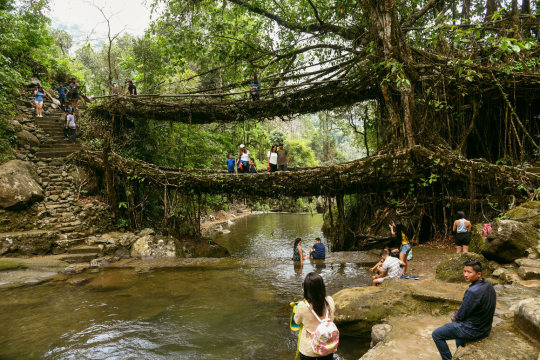
The Artisans Behind India's Living Root Bridges In the dawn of times, there were sixteen primordial tribes who lived with their creator in their heavenly abode, the kingdom of clouds. One fine day, one of these men looked down and discovered a lush paradise, filled with mesmerizing waterfalls, luxurious jungle, and abundant food. He asked the creator to conceive the jingkiengjriksiar, a mythical “golden bridge” formed by a majestic tree which connected the two worlds, and moved with some human settlers into this idyllic land. This is the kind of story that Hally War heard while growing up in northeastern India, cuddled with his siblings around the fire during the long, cold nights. War, now a 68-year-old farmer from Siej village, belongs to the Khasi tribe for whom the concept of a tree bridge is far more than just a foundational legend. For hundreds of years, his people have been not building bridges, but growing them. The jingkieng jri, as the living root bridges are locally known, seem to have sprung directly out of Tolkien's imagination. The interwoven aerial roots create a pervading fairy-tale atmosphere, appearing to connect myth and reality and the past and the future rather than the two sides of the river. Initially, the bridges were created for pragmatic reasons, as a strategy of adaptation to the harsh environment. The southern Khasi hills, in the Indian state of Meghalaya, experience the heaviest rainfall in the world for more than six months annually. A conventional bamboo or wood bridge would be very quickly washed away. “The indigenous builders then turned to their natural environment for harnessing the raw materials and started building structures and bridges across the streams and inhospitable terrain,” writes Ian Lyngdoh, author of the book Ficus Khasiana. The Khasi people invented the art of weaving the roots of ficus elastica, a species of fig tree, until together they become strong enough to form a bridge. “They were great innovators with a practical outlook, and they created a culture which was unique, sustainable and ecofriendly. Inheriting a culture deeply rooted in the environment, the people developed a living architecture that was found nowhere else in terms of its application and philosophy,” Lyngdoh says. These bridges grow stronger each year for as long as the tree is alive; some bridges are estimated to be more than 500 years old and can hold up to 50 people. Realizing how extraordinary this example of tribal botanical architecture is, India submitted a proposal in 2022 for the inclusion of the bridges among UNESCO’s World Heritage sites. The country hopes that such a designation would help to protect 72 different living bridges and other similar structures across Meghalaya. The applicants describe each living root structure as a “distinct ethno-botanical journey rooted in profound culture-nature reciprocity and synthesis,” “an apogee of human-plant relationship” and “a remarkable breakthrough in nature-based design and engineering” while also “contributing to the ecology through forest and riparian restoration." War started to learn how to grow a bridge at a very early age. “I was about nine years old when my grandfather showed me a living root bridge that he was growing across the Ummunoi river,” he says. Noticing the child’s interest, his grandfather, Iang Rapthap, began to share with him the secrets of his work. The old man taught War how to take advantage of the natural characteristics of the pliable aerial roots, showing him their tendency to anchor themselves to other objects and their propensity to combine with each other. The young boy learned how to channel the tiny roots through bamboo, wood, or hollowed-out palm trunks, and to arrange them into the desired architectural feature; how to support the most fragile sections of the bridge with bamboo poles until these were strong enough to hold on by themselves; and so much more. War's grandfather intertwined the lessons with stories from Khasi oral tradition, a fundamental tool that the Khasi people used to instruct their children about their environment and the laws of nature. “The oral tradition meant that there were no written formulas nor documentation on the science of making bridges; it was a skill, a craft, an art, a behavior pattern and an experience that was inherited, passed on from one generation to another,” says Lyngdoh. While entwining the roots, War also learned about the visible and hidden forces surrounding him: he realized which fruits and mushrooms were deadly, which plant leaves he could collect in order to prevent malaria, which ones he should harvest to treat kidney stones, and so on. The most important lesson he learned from his grandfather, though, was the art of patience. Year after year, he watched the roots becoming bigger and stronger, as he himself was slowly growing from a small child to a young man. War understood how the diengjri—as the Khasi call the ficus elastica—was growing in a different time than his own; even if its growth was slower, it would outlast his own existence. He started to recognize the respect his people had for this tree. “The diengjri in some villages is sacred and certain rites and rituals are performed in and around the Ficus tree. It is regarded as the saviour and protector of the forest by the inhabitants,” writes Lyngdoh. For the priests of the traditional religion, “both the ficus elastica and the jingkiengjriksiar [the mythical “golden bridge”] connect the physical and spiritual world and are accorded a sacred character in the culture of the native inhabitants of the region…The imaginary umbilical cord has reincarnated itself in the Ficus tree and in the living bridges of the people.” War’s grandfather emphasized the tree’s transcendental attributes while he was instructing him about the very first step in the process of creating a bridge: planting the seed of the diengjri near the river bank. There was a sort of taboo connected to it. “Only old men were allowed to plant this type of tree. It was believed that the roots would drain away the vital force of the young men and their possibility of generating offspring,” War recalls. This meant that the elder who planted the tree did so as a gesture towards the future generations; he would die long before the tree would be ready to be transformed into a bridge. Fortunately, War's forefathers had foresight. His grandfather showed him the place where a member of the family had planted a seed years earlier. Once a young sapling, it was now a vigorous tree with the perfect attributes to be turned into a bridge. So War enthusiastically began what would become his life’s work, the Umkar living root bridge. He still preserves his grandfather’s bridge, located a few miles away; but he has dedicated most of his spare time to his personal project, patiently weaving and directing the aerial roots across the river. “It took me 50 years of work to establish the first stage,” War says, “and for the last 17 years I have also been working on a second deck,” specifying that he has been developing both levels simultaneously. With time and experience, War grew even bolder. He decided to try to weave a staircase and a viewing deck directly over the small waterfall beneath. “I am even planning to add a third platform,” he says. The bridge is still under construction, but it is already possible to carefully cross a part of it. The structure demonstrated its resilience in 2011 when a tempestuous monsoon washed away the bamboo bridge standing next to War's creation. His bridge stood, surviving the calamity without significant damage. His work involves several challenges. “Most of the time I work alone, and I need to carry the bamboo poles from long distances, which is quite hard during the slippery rainy season,” he explains; the entire community gathers to combine their efforts only in some specific stages of the bridge’s growth. Another problem is the damage inflicted to the structure by people who stand on fragile portions of the bridge, damaging parts which are still too tender. The biggest threat to the existence of these structures, though, is not careless people but the passage of time. The art of weaving and preserving the living root bridges is slowly fading away. “The simplest way of looking at the cause of the disappearance of Meghalaya’s botanical architecture is to examine its primary liability, which is that it takes a very long time to become functional and safe to use,” says Patrick Rogers, founder of the Living Root Bridge project. “Even if a steel or concrete bridge is more expensive and doesn’t have the environmental benefits and longevity of a living root bridge, it will be usable much sooner.” Outside of tourist areas, the villagers often don’t see any practical reason to make the intergenerational investment in such structures, and they are abandoning the construction and maintenance of these bridges altogether. Recently, a few individuals and organizations have started to promote the task of propagation and conservation of the living root bridges. But War began this mission long ago: “This bridge is my life’s purpose. I dream about it day and night; it has become a part of me. I will keep working on this bridge for as long as I can stand, and I will keep teaching my sons and grandsons so they can continue my work once I am gone. And I will plant a seed of the diengjri myself, so that one day someone from my offspring may grow a bridge when the time is ripe.” https://www.atlasobscura.com/articles/living-root-bridges-india
0 notes
Note
Will say though anon


While it’s true that these designs were probably based on the Quetzalcoatl depiction in Aztec architecture, I really don’t know how to tell you this, but like the Aztecs were a Native American empire that was completely wiped out by European genocide.
Like I get what you meant but also the Aztec empire very much was composed of people indigenous to the American continents. It isn’t really better to appropriate a culture that was victim to genocide.

Anyway I think what the creative team were going for with these would be an ancient relative to the Coatl, which are already based off of Quetzalcoatl in physical design albeit far more loosely, and that’s why speaking aloud is not natural for them as it was established Coatl cannot speak due to their snakelike anatomy, and instead hum to communicate.
I see the concerns with the designs looking too much like the headdresses of some North American tribes and also resembling Aztec figures, but I do have a bit more trouble finding an intentional parallel in the short story itself. I can see the way it can be read as offensive and I would agree that the artists may want to run some sensitivity and inclusivity tests by a third party to avoid this happening again, but I’m going to be honest with the way people were talking about it I expected a lot worse.
some people are saying they're problematic bc of the actual lore story, as well as their head crest of feathers (saying it looks like indigenous headdresses). however, i think the crest is more like the aztec quetzalcoatl?
Everyone is being the most vague person on the planet about what the lore is Jesus Christ.
33 notes
·
View notes
Text
Douglasville 1.1 - Arizona neighborhood with pulp storyline for The Sims 2!
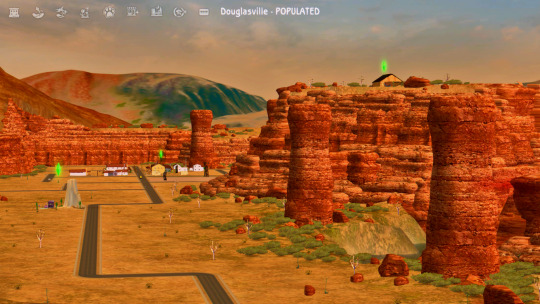
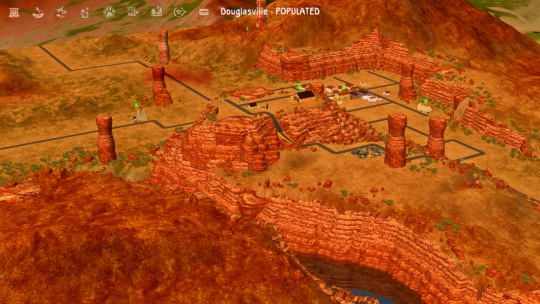

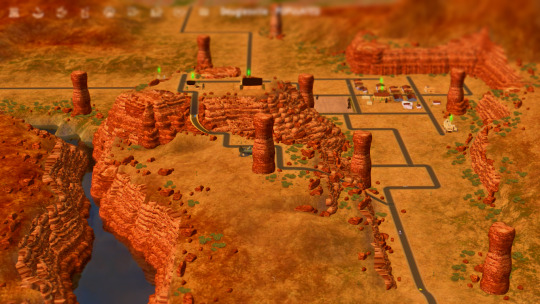
Douglasville is a TS2 almost-cc-free neighborhood based on the Spanish videogame Runaway: A Road Adventure.
This neighborhood is set in the fictional region of the Simrizona Desert and it features: beautiful canyon landscapes, a colorful bunch of characters with unique stories and personalities, a treasure hunt, lots inspired by Mexican and Western false front architecture!
Info and download under the cut
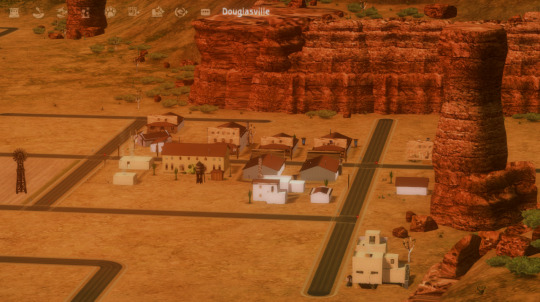

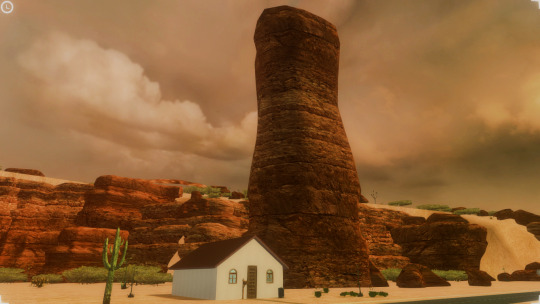
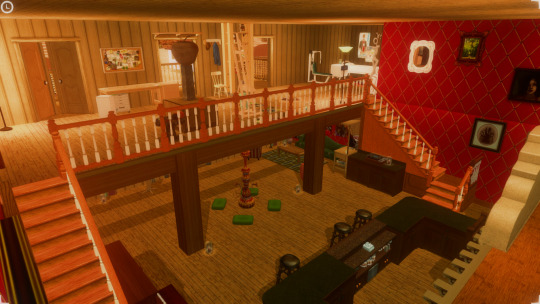
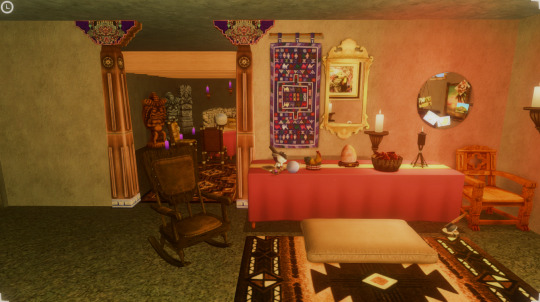
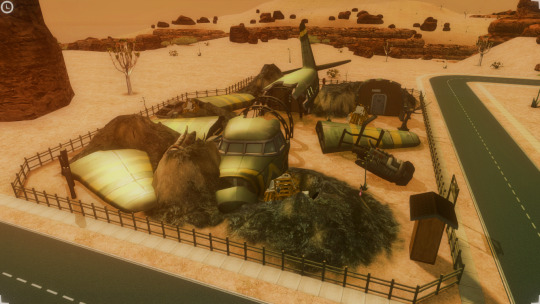
Douglasville allows players to let their creativity loose as they decide the paths of the strange characters who inhabit this land: you will have to make choices, pick a side and let the other sink in this greedy treasure hunt who will probably end up in a few casualties. This neighborhood can be a great start for a Build a City Challenge with a few adjustments, or you can keep Douglasville as it is: a small, dilapidated ghost town for the lonely wolves. Speaking of wolves, be careful because you will find a pack of mexican wolves hunting around the area! The main features of Douglasville are:
◉ A desertic neighborhood decorated with the amazingly beautiful Canyon Pack by Kridershot. Enjoy these ARIZONA-INSPIRED LANDSCAPES, if you can fight the heat and the hungry wolves!
◉ 7 HOUSEHOLDS + 2 SIMS IN THE BIN, all characterized by unique backgrounds and, sometimes, featuring storytelling props in their inventories to help you get involved with their stories.
◉ A TREASURE HUNT! The terrible thugs Gustav and Feodor are searching for the Hopi treasure and they have reason to believe Gina Timmins knows something about it. Who will get their greedy hands on the treasure first?
◉ Lots were built in MEXICAN AND WESTERN-FALSE-FRONT STYLES to correctly convey the atmosphere of the United States' South West area. The hood features ONE STARTER HOME to help you include your own sims in the run for the treasure!
Before downloading, I need to give you some warnings:
⚠ This neighborhood includes references to an existing indigenous tribe from North America: the Hopi Tribe. This is directly taken from the videogame Runaway and it's something I decided to keep. I am not Hopi, so my knowledge is limited, and I did what I could with no custom content. It's important for me to specify that I don't want this neighborhood to disrespect native American tribes in any way.
⚠ There are three drag queens living in Douglasville. To keep custom content to a minimum, I decided to create them as women and change their gender behaviour through SimPE (they have male voices, will pee standing and sexually reproduce as men). If you want to be more realistic, you can change their gender to male and dress them up with custom clothes.
⚠ You need a CAMERA MOD. The neighborhood is big and there are lots on the borders of the map, so without a camera mod you would not be able to play the hood as intended.
Below you will find two download links:
“DGVL” is the neighborhood folder and it must be extracted in Documents/EA Games/The Sims 2/Neighborhoods.
“Douglasville_CC” is the folder containing a small amount of CC required for the neighborhood to appear as intended. It must be extracted in Documents/EA Games/The Sims 2/Downloads. Everything has been sorted in labelled folders to help you organize your cc.
DOUGLASVILLE 1.1: CLICK!
DOUGLASVILLE CC FOLDER: CLICK!
(Don't get scared by the CC Folder size: it's mainly due to the skyline, skydome and canyon pack. Remember to delete custom content that you already have!)
List of Custom Content:
Moocha's Build-A-Bus Kit, Slig's Graffiti, PrincessBliss' native american rug recolors, C&K's oil lamps, TonyVeis' 4t2 Strangerville plane, TNWS's 3t2 rocking chair, chest and curtains from TS2 Store, MommaLisa outfits by MoniLisa, keoni and Slig, historical clothes by Skellington, YanderePlum and SerenityFall, Saturn's hair by Hazelpuff, neighborhood deco by Kridershot and probably leoz94 (I'm not sure!), desert skyline by greatcheesecakepersona, skydome by Lowedeus.
Additional Credits:
The storytelling picture where Gina is running from Gustav and Feodor is set in Katatty's Downtown! Also, thanks to every single person who commented, reblogged, liked and followed this project over these weeks! I am extremely eager to see what you all do with this neighborhood, so feel free to provide feedback or tag me if you share gameplay pictures :) Hugs from Italy!
#ts2#the sims 2#sims 2#ts2 download#ts2 hood#sims 2 download#ts2 neighborhood#douglasville#ts2 desert#cc free#dl: hood#ts2 arizona#ts2 maxis match#ts2 simblr#runaway#pendulo studios
566 notes
·
View notes
Text
“BuT AlL of MiDdlE EarTh wAs WhITE. Tolkien would be ‘rolLiNg in HiS grAve’“
So, if you haven’t heard white proud boys purist Tolkien fans are up in arms over Rings of Power having PoCs in it, because it’s “not historically accurate to European history” (hahaha), and “Tolkien’s intentions”. So I thought I would do a run down on basic European history and Tolkien’s intentions to refute this and the other complaints, plus launch some really valid criticism about the show that’s not about race at all that these fanboys are totally missing because they really didn’t do any of the reading on Tolkien or actual European history.
Yeah, some of you won’t read my profile, but most of this is pulled from my knowledge of European history, Anthropology, and general World building geekery, which is my hidden degree. (I concentrated a ton of classes around this)
PoCs in European history:
For reference, I’m only going to loosely reference real European history since I don’t have a textbook word count to write this out with. This is more a dump and you look it up moment. If you’re not willing to look it up, don’t refute it.
This is rough, but not exact chronological order.
-Beaker People (granted this wasn’t remembered in Tolkien’s time period, but we’re operating on “real” European history.) They brought agriculture to Europe and as soon as about 5000 years ago, the majority of people in Europe were dark-skinned in Southern Europe. White skin likely started with Sami people. White skin only became more common about 4,000 years ago in Southern Europe. In Northern Europe, it’s about 6,000-5000 years ago. With first white skinned people about 8,000 years ago.
(Making it easier, pulling easy-to-read source: https://www.theguardian.com/science/2018/feb/07/first-modern-britons-dark-black-skin-cheddar-man-dna-analysis-reveals
https://www.nhm.ac.uk/discover/news/2018/february/the-beaker-people-a-new-population-for-ancient-britain.html)
Under this specifically: The Cheddar Man: https://www.nhm.ac.uk/discover/cheddar-man-mesolithic-britain-blue-eyed-boy.html
- Early Jews in Europe. Jews weren’t rebranded white until a *lot* later in history. But going over that is cumbersome. Early Jews were from Western Asia.
- Rromani who came from Northwestern India, and were nomadic. (In the show Harfoot is kinda based on Rromani and they are Rromani-coded in many ways). BTW, Roma are the largest group of Rromani, but not all Rromani are Roma. The G-word is a slur.
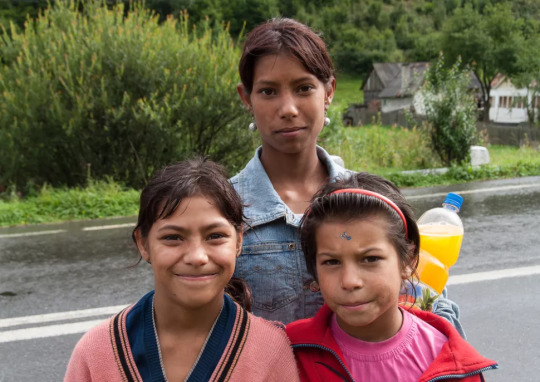
(Image from: https://www.livescience.com/40652-facts-about-roma-romani-gypsies.html)
- Mongols via the Mongolian Invasion, who changed the food habits of Europeans (particularly on meat-eating) and imported from Persia (now Iran) distillation of wine and spirits. (They also brought distillation to East Asia and Russia too).
- Islamic Empire in Al Andalus (Southern Spain) and later the Moors that came there. Al Andalus brought Renaissance to Europe. Gothic Architecture--that’s them. The pointed arches are something they brought. Love Poetry/courtly love, modern medicine, Scientific method, astronomy (astrology somewhat), algebra, sciences, formal academies, etc. They collected from India, so brought eh Zero from India, decimals from China, etc. (BTW, Automatons still blow my mind)
- Crusades brought in Northern Africans.
- Slavery from Western Africa brought in black people in Tudor times.
- Colonization of the Americas brought in Indigenous people, though not ethically done. Such as Pocahontas, who went to England to negotiate treaties, etc.
- Outside of this, there were stone masons brought for building castles from Western Asia and Northern Africa. This is covered by Ruth Goodman in the documentary about Guédelon Castle, who explicitly cites this to be the case.
- Math was invented by Egyptians, Congo people, Babylonians and Sumerians--none of which are in Europe.
- Arches is West Asia-ish, not Europe.
- Metal work, is likely started in Africa. (Most likely North Eastern)
- Spoons started in Africa.
- knives start in Africa.
- Strawberries (mentioned in the show, BTW) is New World, and BTW, I think Tolkien would be against it given his writings on food. He was particular about it. While the strawberry was cultivated in Roman times the varietal used today was cultivated first by the Mapuche and Huilliche Indians of Chile cultivated the female strawberry species until 1551, and the formal domestication of the strawberry in Europe, as we know it, is not until the 18th century. https://en.wikipedia.org/wiki/Strawberry
- Blueberries are also New World: https://en.wikipedia.org/wiki/Blueberry, having the cultivated origin in North America, though they naturally occurred in Europe.
- Grains came from Western Asia--all of them, which allowed the domestication of other things, like strawberries, carrots, etc. The earliest staple from food historian’s thought was marsh reeds in Europe, which take a long time to prepare. Brussel sprouts, BTW, are 100% European in origin. (In the cabbage/Broccoli family, which is also found outside of Europe)
-Marigolds (mentioned third episode with the Harfoot) are Mexico and Guatemala in origin, imported in the 16th century:
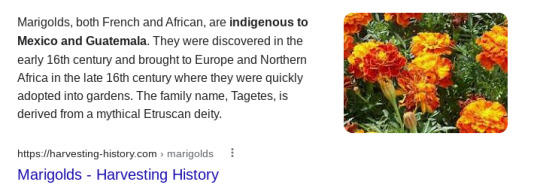
- Humans started in Eastern Africa by best guess.
- Horses is Asia, likely. Central Asia, though disputed on which culture came first: https://en.wikipedia.org/wiki/Botai_culture https://www.statelinetack.com/blog/the-history-of-horseback-riding/1595/
- Boats were invented by Phoenicians--who were not European.
If we’re getting later in history....
- Jane Austen discusses slavery during the Regency period. And Belle is roughly from the same time period (Movie about a black woman, who was a granddaughter of an Abolitionist judge based on historical figures).
- British occupation of India and Pakistan brought in Indians. One of the servants of Queen Victoria was an Indian man. She also had a black goddaughter.
- The Suffrage movement also included women of color, though rather erased from history.
- British colonization of Jamaica also brought in more black people. (Granted after Tolkien)

So the idea that looking at this map of Europe and Africa, no black people or PoCs would be in Europe is ridiculous, because Europe had a forcefield around it that prevented people from coming in. People always travel. I mean Queen Cleopatra, anyone? Anyone? She traveled from Egypt to Rome.
Homo Erectus made it all the way to China without airplanes, boats, horses, and suddenly Homo Sapiens sapiens can’t travel to Europe, just across a lake? That’s not realistic.
https://en.wikipedia.org/wiki/Peking_Man
https://www.newscientist.com/article/2150253-gene-study-shows-human-skin-tone-has-varied-for-900000-years/
https://www.quora.com/If-all-humans-belong-to-the-same-race-when-did-they-start-to-have-different-colours/answer/Walter-Smyth
But Tolkien WAS FOR WHITE PURITY:
https://www.good.is/articles/jrr-rolkien-nazi-letter
He hated the Nazis and if you read that article:
“Privately, according to “1937 The Hobbit or There and Back Again," Tolkien told Unwin he hated Nazi “race-doctrine" as “wholly pernicious and unscientific." He added he had many Jewish friends and was considering abandoning the idea of a German translation altogether.”
So no, he was not for “race purity”
I mean look at this burn:
25 July 1938 20 Northmoor Road, Oxford Dear Sirs, Thank you for your letter. I regret that I am not clear as to what you intend by arisch. I am not of Aryan extraction: that is Indo-Iranian; as far as I am aware none of my ancestors spoke Hindustani, Persian, Gypsy, or any related dialects. But if I am to understand that you are enquiring whether I am of Jewish origin, I can only reply that I regret that I appear to have no ancestors of that gifted people. My great-great-grandfather came to England in the eighteenth century from Germany: the main part of my descent is therefore purely English, and I am an English subject — which should be sufficient. I have been accustomed, nonetheless, to regard my German name with pride, and continued to do so throughout the period of the late regrettable war, in which I served in the English army. I cannot, however, forbear to comment that if impertinent and irrelevant inquiries of this sort are to become the rule in matters of literature, then the time is not far distant when a German name will no longer be a source of pride. Your enquiry is doubtless made in order to comply with the laws of your own country, but that this should be held to apply to the subjects of another state would be improper, even if it had (as it has not) any bearing whatsoever on the merits of my work or its sustainability for publication, of which you appear to have satisfied yourselves without reference to my Abstammung. I trust you will find this reply satisfactory, and remain yours faithfully, J. R. R. Tolkien
He also hated Hitler, a whole ton (and as cited in the article had a bunch of Jewish friends):
“I have in this War a burning private grudge—which would probably make me a better soldier at 49 than I was at 22: against that ruddy little ignoramus Adolf Hitler (for the odd thing about demonic inspiration and impetus is that it in no way enhances the purely intellectual stature: it chiefly affects the mere will). Ruining, perverting, misapplying, and making for ever accursed, that noble northern spirit, a supreme contribution to Europe, which I have ever loved, and tried to present in its true light.”--J.R.R. Tolkien, The Letters of J.R.R. Tolkien
https://www.goodreads.com/quotes/325144-i-have-in-this-war-a-burning-private-grudge-which-would
He also called Hitler a “Mongrel”:
https://www.facebook.com/GOODHQ/posts/jrr-tolkien-hated-nazi-race-doctrine-and-no-problem-telling-his-german-publishin/10157470976163059/
BTW, some suggest Moriquendi had dark skin.
Tolkien also refuted all claims of racial purity during his lifetime about his world:
https://en.wikipedia.org/wiki/Tolkien_and_race
So, no, he would hate you for acting like an incel neo-nazi.
In addition he often tried to update his worldbuilding to fit “science” seen here (BTW, this is the Victorian Literary movement called “realism”):
https://en.wikipedia.org/wiki/Round_World_version_of_the_Silmarillion
Since he wanted a round world, PoCs are required for it. Closer to the equator you would get PoCs. Plus it would screw over the Nazis really well to have all this info on humanoid populations. And I think he’d be for that. Despite the fantasy, he still liked the idea of rooting it in science and history, if you look into his writings (particularly about the foodstuffs)
I should note that CS Lewis, who was his friend and often had writerly disputes with him, was for a flat world model, which is probably some of the influence on the flat world idea.
BTW, I kinda like in a symmetry of mythology take, the idea that Valinor would be sucked into another realm in order to make the world round, which would solve a lot of his issues with making a round world. It fits a lot with the whole Valhala, Anglo-saxon, etc mythos he based it on.
And about the Harfoot in the show:

As I said, coded Rromani.
But Black Dwarves, caves, etc and auto-white skin
People forget that Inuit exist? (If not Rromani)
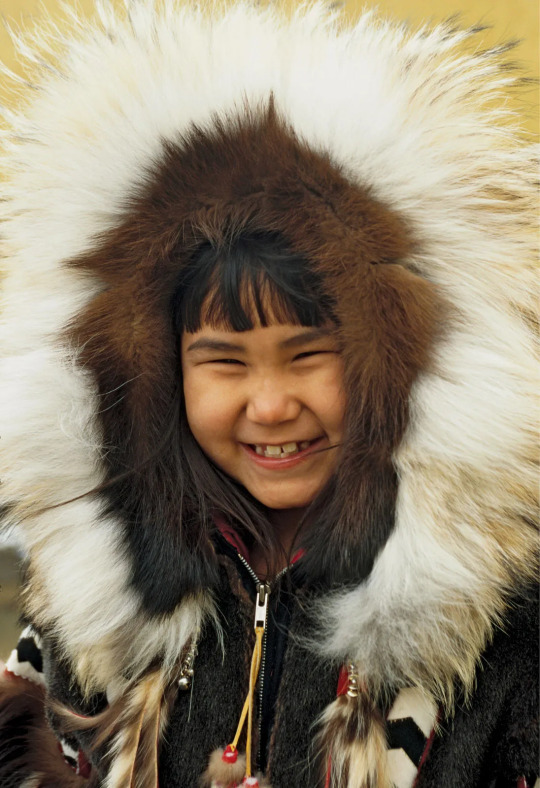
(Image from Encyclopedia Britannica) Where do they live? Far more North than the Latitude this is set.
If you’re arguing that Dwarves “need to be all white” then you should be arguing they are all albino https://www.insidescience.org/news/albino-sharks-deep), and more like mole people or naked molerats. But they have really good eyesight throughout LoTR, so apparently they aren’t “adapted” to the caves.
So that means they are getting all the essential vitamins in those caves, which has a tree and several green plants in Rings of Power.
They must be eating something similar to seal blubber or maybe the bones of fish and animals.
If that’s the case, such that they haven’t lost all their pigmentation, as in the case of Albino sharks, cited, then having a black dwarf isn’t far-fetched. As noted, the majority of the human population for quite some time was black, considering homo sapiens sapiens are 200,000 years old.
So humanoid creatures with an argued similar biology as they are trying to pull here, would stand to reason being black in a cave isn’t a disadvantage at all. And notice it took a few thousand years of agriculture for white skin even to be more common in Southern Europe.
The “realism” vs. fantasy--real problems.
Because they are going on about “realistic” but only harping on PoCs, I thought I would point out the more pressing world building issues they should have picked up on if they had any knowledge of actual European history and the whys of it all. Icing on the cake?

- In the middle of an icestorm, acting like a fighter, and hasn’t tied up her hair?
Loosely the clothes are somewhere between Preraphaelite, which is Victorian Imagination of clothes and 12th century clothing:

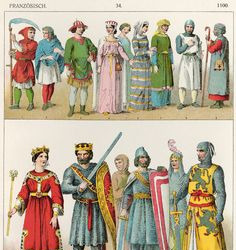
Actual 12th century clothing.
But you’ll notice in the real ones, the hair isn’t down like in the Victorian imagination of the Medieval period. The proper way was to cover ones hair. (Mostly to keep dirt off of it.)
Joan of Arc also cut her hair first thing: https://www.history.com/news/7-surprising-facts-about-joan-of-arc
So Galadriel with her hair down fighting people like she has it, would be a death sentence waiting for her. It would get caught in the chainmail hood, frozen to things, and blow around. It would get her killed. I don’t think Tolkien would be in favor of the impractical. It should be braided at least or put into a bun and probably covered, as shown above. Edit: They fixed this in Episode 6, by finally giving Galadriel a braid, BUT I was honestly thinking something more like this: https://www.howcast.com/videos/500081-how-to-do-a-heidi-braid-braid-hairstyles
Or a viking battle braid. https://therighthairstyles.com/viking-braid-tutorial/
- The clothes aren’t designed for horse riding:
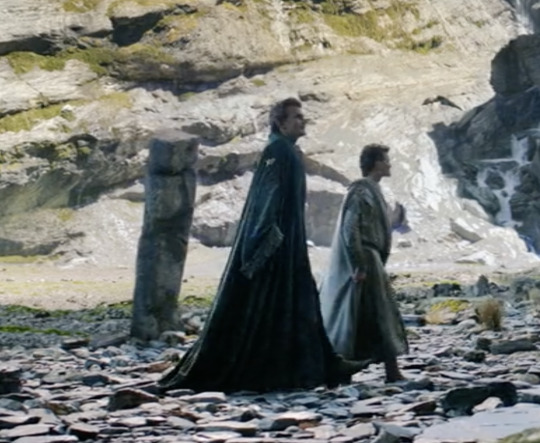
*sighs* Elves in LoTR habitually rode horses. Tolkien has large swaths about this.
And traveling in a robe like that in a distance like this:

No way that robe would stay that clean. It’s impractical. Often Kings through modern time would switch robes for riding. Riding in that clothing would be cumbersome. It doesn’t split in the right places, and it drags and it would collect dirt like no one’s business.
I don’t think that Tolkien, who went on and on about horses, would be in favor of clothes you can’t use for horse-riding when clearly horses are present. I mean even the Preraphaelite painting is more practical for horse riding than these clothes.
Yes, hand wavium with magic, but why not use an eagle or show that they magically appeared there (Which BTW, is a cheap effect) instead of the slow progress on the board? (Horses are expensive?) Still, the clothes need to be good for horseriding. Also, horses are not cars, so they’d probably have to stop along the way if it exceeds about 20 km. (’cause Tolkien is British), so the clothes would have to be changed. Note: Kinda fixed this later. A little. Starting in Episode 5, but I still think the clothing should keep in mind horses. Horses show up in episode 6, but are kinda mentioned before then.
Geography issues:
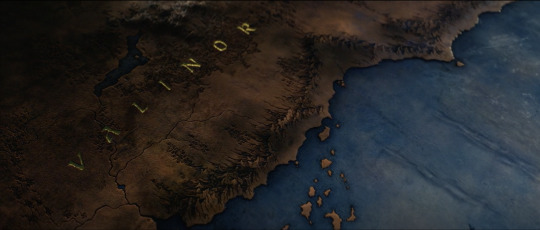
There is nothing on this part of the map which would make Middle Earth temperate in climate.
You see, the reason Europe gets to have agriculture besides the Beaker people is because there is the Gulf Stream, which throws all that warm water from the Gulf onto Europe. Without it, Europe would be, as my Geography teacher liked to say, “Siberia” And as he said, if you keep melting those icecaps, Europe will turn into Siberia’s climate, with really hot summers and really cold winters.
This isn’t part of Tolkien’s original map, so it’s not on him, but if we’re going by “realism” and “real history” and OMG, PoCs in Europe, shouldn’t the fact that Middle Earth be a barren wasteland without matching continent concern any of that crowd (yes, I know, white purists don’t really care about “real history” even when spouting it.)
BTW, some people lose their minds to find that agriculture+the Gulf Stream made them white. Downright angry. ‘cause then white people aren’t necessary in world building. But anything to piss off the white purists.
I should be clear, I’m willing to let these details go, and do hand wavium in my head, but really, if they are thinking Middle Earth is “real” history, shouldn’t they be more concerned about these three things than some scattered PoCs, most of which are not named? Five, first episode +2 second episode (only one of the two named). But no~ black people are “taking over” because of ~5 blacks in the first and +2 in the second. (And one of the two is on screen for less than a second--blink and you miss them). And I’m thinking, wait until they find out about the stone masons, Moors, Mongols, and West Asians in Europe. And Rromani.
Conclusion:
The thing is the majority of the people complaining are racists who want Europe to be a white haven of whiteness going back 10,000 years. They don’t really care that much about reality, in the end, and are basically doing the work of Hitler going on about White Purity of Europe and using Tolkien’s name in vain. But look, Tolkien was against that. He HATED Hitler. Hated him. Was willing to say so and have a hit put out against him. Was willing to give up German pub rights to hate Nazis. And Tolkien actively fought in his lifetime against Middle Earth being race-framed into being about white purity.
So I don’t get that.
25 notes
·
View notes
Text
A personal rant about why I dislike the inclusion of Celestica/Volo in PLA, or rather, the way it was used
If you're expecting a nicely organized essay, move along. This is one giant brain dump that has been percolating in my brain for months, and I just needed to get it out.
Comments and asks are welcomed, but don’t expect to hide behind anon. You want to talk? Let’s talk.
Volo and Celestica are interesting in Pokemon Legends Arceus. And by interesting, I mean “why the hell are you here?”
There are the known parallels. Sinnoh is the Pokemon version of Hokkaido. Hisui has a new name because Hokkaido used to be known as Ezo by the local indigenous population - the Ainu.The Galaxy Expedition Team is obviously a parallel to the Japanese government colonizing (yes colonizing) Ezo into Hokkaido.
So that leaves the Ainu. My thought was that the Diamond and Pearl Clans are the Ainu parallel.
So where does that leave Volo and Celestica? Well, Celestica is the Greeks, and Volo is an entitled brat.
Confused? Let me explain.
Well, as this graduate student on AO3 writes, there’s a pervasive idea in Japanese history that the Greeks lived in Japan long before anyone else did. The TL;DR of the post is that based on the architecture of one important temple in Japan, the Greeks had contact with Japanese soil back in the BCE era. That theory includes the idea that the Greeks settled Hokkaido before the Ainu.
Now, if we take the parallels from above, that sentence becomes: The Celestica people settled Hisui before the Diamond/Pearl Clans.
This would explain the Temple of Sinnoh being very, very Greek-like, down to the Parthenon style building its in. It also explains why Volo wears that chiton Arceus outfit - because he’s Greek coded.
Now, why does this make me mad? Simple - because it makes it look like the Diamond/Pearl Clans are like the Galaxy Team - colonizers taking over a land that isn’t theirs.
And it's not just that. The Old Verses bring it up as well. And let me break down why it makes me mad!
Take Old Verse 5:
The first line is clear: Long and longer yet ago, Celestica was here. But folk and town alike, both did disappear.
Celestica was in Hisui, and for some reason they “disappeared.” We have no idea why they disappeared. The only clue of what happened to them is most likely in Old Verse 20, where it states that the writer’s people - ostensibly Celestica - ‘weep, to grief we fall, starved of light now it has gone.’ We know something happened to the people of Celestica. But it continues with “And some they go, despair withal, in search of it they reel and run. They quit their hearths, abandon hall, and leave our lands to be undone.” I read this as the people of Celestica choosing to leave, not being forced out, especially when you read the next part.
Back to OV5, the second and third lines are: In time, came new folk sailing, sailing ‘cross the sea, called by their love for Sinnoh, great and almighty. But diff’rent were the Sinnoh that each folk did hold dear, And bitter strife and angry war were always at the near.
The arrival of the Diamond and Pearl Clans. Reading between the lines, we see that the clans came after Celestica left. And they were called to Hisui by their love of Sinnoh. Eventually, they fall into battle because they can’t agree on who’s the “right” Sinnoh, leading to the clashes that made the Clans dislike each other.
The fourth and fifth lines: ‘Celestica’ they called themselves, the name not theirs to take. Yet claim it from the past they did, for tragic quarrel’s sake. So once again did our name live, though all our people gone. But even if the name endures, its heart does not live on.
Now these lines. These lines grind my gears.
I have scoured the game, looking for where the Clans claim to be Celestica. There is only one place I can find it: on the Celestica Flute.
And I see nothing that tells us where ‘for tragic quarrels sake’ the clans claimed the name.
The only other places the names of Celestica are found are in the ruins.The Celestica Trail and Ruins in the Coronet Highlands are the most obvious.There, you also find the Primeval Grotto, Ancient Quarry, and Sacred Plaza (where the statues of Dialga, Palkia, and shattered Giratina are). Outside of the Highlands, there’s the Shrouded Ruins and Solaceon Ruins in the Mirelands, but that’s it. Of course, that’s not to say there aren’t other, non-named locations of Celestica ruins, but I have only ever seen them in the area’s I named above.
Now overall, why does this Verse make me mad, besides what I said above?
There’s a couple of things. For one, it insinuates that the clans don’t have the right to call Hisui their home. Just like the Galaxy Team, they came to Hisui and took over; they were not born on the land. Except that’s just human migration. Celestica left Hisui for some reason, and the clans came upon an empty land and settled.
For another, it claims that the clans ‘took over Celestica’s name’, but again, there is no evidence for that claim. The clans came to Hisui following Dialga and Palkia. There is no proof that the clans even knew much about Celestica except for the ruins that remained. (And their interactions with Celestica architecture is interesting as well, but that's a discussion for another post.)
And then, Volo. Volo comes in, claiming that because he holds the blood of the ancient Sinnoh people, he is…. *checks notes* you know, I have no idea what blood has to do with anything.
In the post game, Volo takes you on a journey to find the plates and Arceus. Then at the Highlands, he drops this tidbit. “You see, ever since I was young, whenever I met with something painful or heartbreaking... I couldn't help but wonder why life was so unfair. Why I was cursed to live through such things. Of course, I imagine we all go through something like that. Eventually, I chose to direct all my energy into my own natural curiosity and ambition. And what tickled my curiosity more strongly than anything were the mysteries to be found in legends, in history, in ruins... You see, I fancied that by unraveling these mysteries, I could find out how the world itself came to be–and with that knowledge, maybe even forge a new, better world!” Then you meet him at the temple, and you meet Arceus-hair version Volo. No more lead up, just *BAM* Greek Volo.
There's the subtext, of course. Volo claims to be Celestican, and has all the knowledge about the plates, the myths, ect. Ergo, one can consider that Volo learned all of this as a way to reconnect with his heritage. But that doesn’t fit, when you consider his ultimate goal: If I can meet Arceus myself, then I may also be able to subjugate its power... And using that, I will attempt to create a new, better world!
That… doesn’t sound like someone who wants to reconnect with his heritage. It sounds like a bratty teenager who’s mad that their parents enforced a curfew, and are moodily claiming that when they have their own house, they’ll never have a curfew. But ‘their own house’ is running back to the home their great-grandparents lived in and trying to evict the new residents, all while working with a loan shark to tear the house down to build one that suits them better.
So, let’s tie it all together.
Gamefreak has written a game that perpetuates a historical theory (that can’t be proven or disproven because of lack of evidence) that the Greek’s colonized Hokkaido before the Ainu (Aka, Celestica lived in Hisui before the Diamond/Pearl Clans). They claim that the Clans appropriated Celestican culture and presented it as their own, despite the fact that we see no sign of what is Celestican versus Clan based, after such a long time.
They barely touch on it until the end game, where a blonde hair/ light eyed white skinned male coded character suddenly claims to be a heir to the land of Hisui. Volo feels they are entitled to their God’s favor, because they learned and searched for a way to meet Them. This becomes using God’s ‘banished’ child to cause another tantrum to call Them down. When the child that God sent to defeat them wins, Volo refuses to learn his lesson and states that he will meet Arceus and conquer it.
And now, the real world implications.
The Ainu aren’t the indigenous people of Ezo/Hokkaido. The Greeks are.
Therefore, the Japanese government did nothing wrong in forcefully colonizing the Ainu people.
In game, can you see Volo as indigenous? Sure. But I’d be more inclined to think that way if we had more signs of other Celesticans. Or hell, instead of Celestica, a third Clan that followed Giratina. If Giratina was banished, then so was its clan. And Volo is here to get revenge for that.
But no. We just get a man who wants to remake the world because someone was mean to him.
#pokemon legends arceus#pokemon rant#my writting#my issues with volo and celestica go beyond bad writing and poor twist villainy#spitting all my thoughts about them in one post#i should clean this up and make it flow better#but im too lazy to fix it
47 notes
·
View notes
Text
Done being conflicted. Had a decent debate and conversation that brought me down to my own opinions.
Please read below if you care. If you don’t, feel free to pass up.
Also, just to be clear, this is just my opinion (that I think I should have as a brown girl). Feel free to leave a reply or reblog this and counter-argue or ask any questions that you may have respectfully.
I like debates but not arguments.
My opinions:
I don’t care for the live-action characters being the same colour when it has nothing to do with the story.
I also don’t really want a live action for every single movie we watched as kids.
Aladdin did good, Beauty and the Beast did good, and Cinderella did good. Sure. I agree. But not every og animated movie has to be made into a live action. Like I think we can all collectively agree that the Lion King live action wasn’t needed. The Little Mermaid was nice but so downplayed due to all the hate floating around it. I loved it personally and definitely recommend it to anyone who hasn’t watched it and wants to.
As for the whole colour-swapping or changing (idk what exactly the term is but I think both work), I honestly couldn’t care more about the colour when it has nothing to do with the storyline or character development.
I’ve some argue about Rapunzel being German, which I get, but at the same time, I didn’t know she was supposed to be German. The kingdom Corona itself doesn’t exist on the map, so I always assumed it was just there, like a fantasy place (which it is. I did my research). The architecture and landscape was based off of somewhere around 16th or 18th century Poland and Germany. So I get why people would want a German actress to play Rapunzel.
But all the actresses I’ve seen that people want to cast as Rapunzel are not German. If someone knows an eighteen-ish year old German actress with green eyes, let me know. I would genuinely love to know.
Now for the people who are saying they want a green eyed and blonde haired actress, I got some news. Rapunzel is a natural brunette. Her natural hair colour is brown. The only time she has blonde hair (both in the movie and series) is when she’s got her glowing and healing hair (which, for the most part, is the case, but it’s not her natural hair and no one really has naturally 70 feet long glowing blond hair).
So what you guys really want (if you want a true-to-the-original-animated-film Rapunzel) is a German, green-eyed, brunette actress who is between the age of eighteen to twenty-two (only because of Flynn’s age being 26ish which would be weird if the actress is actually 18).
Avantika is a natural brunette, but she doesn’t have a German background or green eyes. She’s got the innocent features though.
Any actress they end up casting would have to wear a 70 foot long wig. Contacts exist. And, as I’ve said before, if the race isn’t essential to the plot, then I genuinely don’t think it’s an important detail.
For instance, the people saying things like taking the handful of POC princess and turning them white; Mulan is based quite literally in China, not a fantasy land, and is based on a Chinese legend; Tiana’s race is essential to the plot and the way she developed; Pocahontas is (pretty much common sense) literally Indigenous and is based on a real person (do some research on her because her story is depicted very differently in the Disney movie).
And, just to be clear, none of these princesses/characters are South Asian so one singular representation shouldn’t be too harmful. There’s always going to be the original version available.
As mentioned before, if you’ve read this and feel like “hey, I think this might be wrong/I disagree, let me tell her”, please do so respectfully and politely. Let this be a civil conversation please.
I like debates but not arguments.
I’m so conflicted about the alleged casting of the live action Tangled.
4 notes
·
View notes